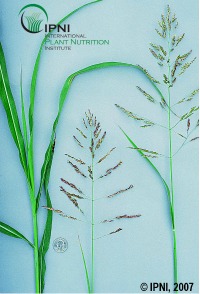Johnsongrass
 Like Dallisgrass, Johnsongrass is not recommended for new plantings, but it can be utilized in the forage production system. See Establishment Guidelines for Grasses for seeding details. Johnsongrass is a tall-growing, perennial that very aggressively spreads by rhizomes and seed. The rhizomes (underground stems) send up shoots from the joints to produce new plants and seed dispersal can cause Johnsongrass to become a very invasive weed in hay fields.
Like Dallisgrass, Johnsongrass is not recommended for new plantings, but it can be utilized in the forage production system. See Establishment Guidelines for Grasses for seeding details. Johnsongrass is a tall-growing, perennial that very aggressively spreads by rhizomes and seed. The rhizomes (underground stems) send up shoots from the joints to produce new plants and seed dispersal can cause Johnsongrass to become a very invasive weed in hay fields.
Johnsongrass is best adapted to moist, fertile soils and can be grazed or harvested for hay or silage. Though common in many pastures, Johnsongrass does not tolerate close grazing. Johnsongrass belongs to the sorghum family, and when stressed by dry weather or cold temperatures it can contain high levels of prussic acid, which is toxic to livestock. Johnsongrass is also an accumulator of nitrates and may develop toxic concentrations of nitrate during periods of drought.
Dr. Dennis Hancock
Forage Extension Specialist
Crop & Soil Sciences Dept.
